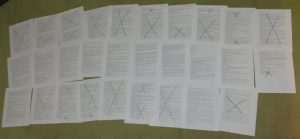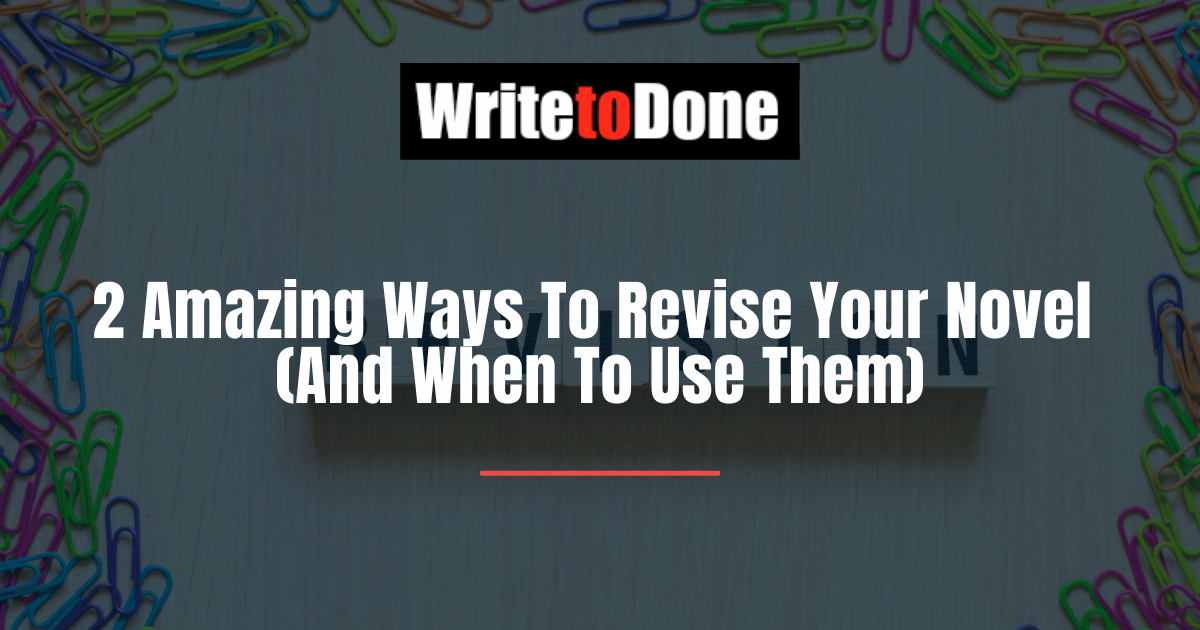You know you need to revise your novel, but where do you begin?
The complexity of a novel can be overwhelming.
50,000-150,000 words means you can’t keep everything in your head.
Flipping back and forth between hundreds of pages makes it hard to remember where you are. You can’t see the story’s structure.
Or can you?
Two methods allow you to actually see the structure of a story, regardless of its size.
#1. Shrunken Manuscript
Purely by accident, I invented the Darcy Pattison Shrunken Manuscript Technique. I was broke, but had agreed to review a manuscript for a friend.
In an attempt to be thrifty, I took a novel and shrank it to the fewest possible pages before printing. I single-spaced the manuscript, took out all white spaces at the beginning and end of chapters, and then shrank the font to 8pts.
Hard to read? Yes! But half the number of pages.
Suddenly, an amazing thing happened. I could see the story structure. A whole chapter took up only one page. Act 1 was a mere 5 pages. This was easy to see, understand, and evaluate for story structure.
Ideally, shrink the manuscript to about 30 pages, which will eventually lie on the floor in three neat rows of ten. For longer stories, try putting everything into columns, or shrink to 6pt font, since you won’t really be reading from this copy.
If all else fails, evaluate the manuscript in two chunks of about 30 shrunken pages each.
First, mark the scenes or pages you are evaluating with dark markers. (Yellow highlighters don’t show up at a distance.) For example, you might mark the places where the villain and protagonist are in direct conflict, whether it’s just a couple of paragraphs, a scene, or an entire chapter.
Then, lay the pages on the floor or on a large cabinet or table. Stand back to look over the story and evaluate.
You can clearly see the frequency, duration, and location of protagonist-villian interaction. If these interactions are not appropriate for your book, you can plan an effective revision.

For my middle grade novel, SAUCY AND BUBBA: A Hansel and Gretel Tale, I shrank the manuscript, and marked places where Krissy, the stepmother, interacts directly with Saucy, the protagonist. Because of story events, Saucy and Bubba run away from home, which means there are no direct interactions in the story’s middle, except for a brief phone call. Acts 1 and 3 are full of interactions, though, so this is a successful structure for this story.
#2. Spreadsheet Plotting
The second method of evaluating a novel for revision involves Spreadsheet Plotting.
Here, you use your favorite spreadsheet software to create a chart that summarizes your story. Create columns with labels such as: character name, setting, main plot, subplot, #words, and so on. Include whatever categories fit your needs. For example, mystery writers may want to include a column for clues.
Next, create rows for either scenes or chapters, depending on how deep you want to delve. Fill the information into the grid.

In this version of spreadsheet plotting, I used columns for Act#, Headline (short blurb for chapter), Day (time of year), POV, Setting, Action, and Emotion. Create columns to fit your genre of writing.
You decide what information goes into a column. In the main plot column, for example, you may simply indicate Act 1, Act 2, or Act 3, or you may be more specific.
For example, my novel The Hero’s Journey has clearly defined steps: ordinary world, call to adventure, meeting with mentor, crossing the first threshold, tests/allies/enemies, approach to the inmost cave, supreme ordeal, reward, the road back, resurrection, and return with elixir.
When your grid is ready, you can sort your novel according to any of the columns you’ve created.

I sorted the Spreadsheet Plotting by setting. You can see that 3 of the Act 1 scenes are at Home, and 16 of the Act 2 scenes are at Home. However, there are no Act 3 scenes at Home. Is this right or wrong? Only the author can decide.
Caution: Be sure to use consistent language, especially the first word in the entry, so the sort works well. If you write “kitchen scene” in one place, but “baking cookies” in another, the sort won’t catch that the cookies are baked in the kitchen.
Shrunken Manuscript vs. Spreadsheet Plotting
Both shrunken manuscripts and spreadsheet plotting reduce a novel to a manageable level.
At-a-glance analysis is simple in either method. However, each method has its strengths and weaknesses.
Because a shrunken manuscript uses a tiny font, it is hard to read the text. That’s usually alright, because you don’t need to read it; you only need to know what happened in a certain section. However, the tiny font does cause a problem for some people. You can alleviate this by leaving chapter titles or other key identifiers in a large font.
The advantage of a shrunken manuscript is that it shows proportions.
Let’s assume you marked your five strongest chapters with a bright X. (Five chapters works well for up to about 40,000 words; after that, mark another strong chapter for each 10,000 words.)
When you evaluate the novel, check to see which marked section is longer or shorter. In other words, you’re evaluating the proportions, or how long each event occurs.
I often find that an author marks the final chapter as a strong chapter. Good! The climax is usually the final chapter, and it should be strong.
But too often, that final chapter is only 3-4 pages long, compared to other chapters of 10-15 pages each. This means the chapter happens too quickly; it isn’t strong enough.
Climaxes should take up an extended space in a novel, creating a big scene that drastically changes the characters’ lives. Shortchanging the climax means a flat ending and a reader who feels cheated. This common mistake is easily seen in a shrunken manuscript.
The advantage of spreadsheet plotting is the ability of a spreadsheet program to sort.
You can click on any column and sort it into ABC order. Let’s assume you have scenes that take place in twelve different settings, but the most emotional setting is your mother’s kitchen.
By sorting, you can see where in your story’s structure kitchen scenes occur. If only one scene occurs in the kitchen, perhaps the emotional content is weak.
If ten different settings occur only once in the novel while the kitchen setting is repeated often, the story may be drowning in kitchen (emotions) and lack variety in setting.
Spreadsheet plotting can give you information on proportion, with a column for word count; but it isn’t visual enough.
A shrunken manuscript can be sorted using color-coding, perhaps using purple to mark scenes in the kitchen and red to X scenes in the garden. But it’s clumsy compared to sorting a spreadsheet column.
In other words, these are complementary tools that tell you something about your story.
Use the two methods in conjunction as you revise your novel, because the biggest advantage of both techniques is shrinking your novel to a manageable size that allows you to see the story at a glance.
When you want a simple count of how many times an event takes place in a certain setting, use Spreadsheet Plotting. Try this technique to evaluate POV, chapter length, or emotions.
When you want to see proportions, use a Shrunken Manuscript. It tells you not just where an event happens, but how much space it takes up.
When would you use one technique over the other? Let us know in the comments!
















